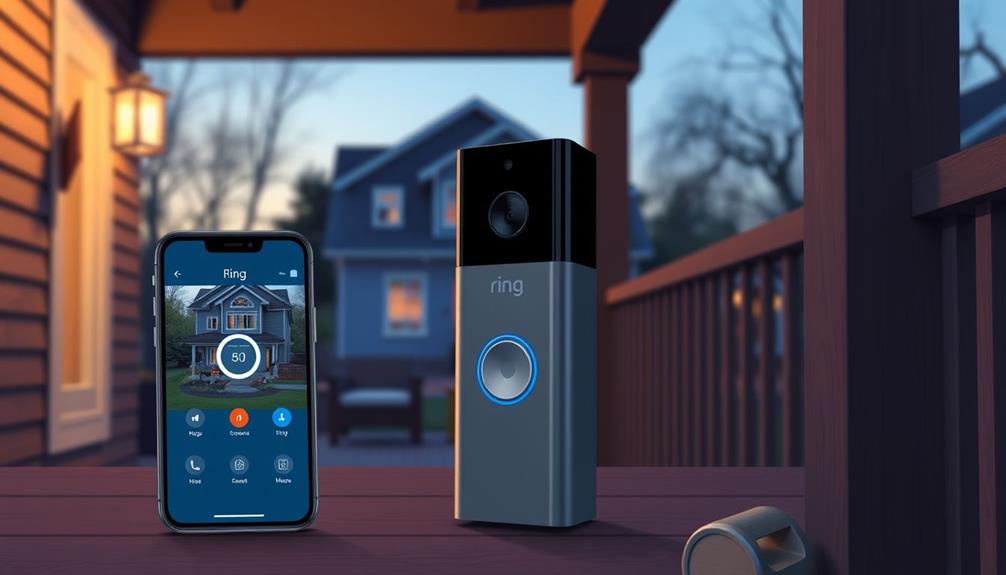Ring’s end-to-end encryption secures your video and audio streams from interception during transmission and protects stored footage with strong encryption. However, it doesn’t prevent unauthorized access caused by weak account passwords, physical tampering, or network vulnerabilities. If you’re concerned about overall privacy, there are other factors to think about besides encryption. Keep exploring to understand the full picture of what’s protected—and what’s left exposed.
Key Takeaways
- Ring’s end-to-end encryption secures data during transmission and storage, preventing third-party access and interception.
- It protects live video, audio streams, and stored footage from being viewed or intercepted by unauthorized parties.
- Encryption does not safeguard against compromised account credentials, physical tampering, or hardware vulnerabilities.
- Device security depends on firmware integrity; physical access can bypass encryption and compromise data.
- Network vulnerabilities and user-related risks (e.g., weak passwords) remain outside the scope of Ring’s encryption protections.
How Ring End-to-End Encryption Works

Ring End-to-End Encryption secures your video and audio streams by encrypting data at the source and decrypting it only on your device. The end-to-end mechanics involve using robust encryption protocols that scramble your data before it leaves your device, making it unreadable during transmission. Only your device holds the decryption keys, ensuring that no third party, including Ring or anyone intercepting the data, can access the unencrypted content. These encryption protocols, such as advanced algorithms, work seamlessly behind the scenes, providing a secure communication channel. As a result, your video and audio stay private from the moment they’re captured to when they reach your device, offering peace of mind that your data remains protected throughout the transmission process. Additionally, understanding the underlying encryption methods helps users appreciate the level of security involved.
The Scope of Data Protected by Ring Encryption

With Ring encryption, your video and audio streams are protected from interception during transmission. This means your live feeds stay private as they travel between your device and Ring servers. Additionally, stored footage is encrypted, ensuring your recordings remain secure even if accessed without authorization. However, it’s important to note that data privacy challenges in the broader context of cybersecurity can still impact overall security.
Video and Audio Streams
Because video and audio streams are primary sources of sensitive data captured by security devices, they fall squarely within the scope of Ring’s end-to-end encryption. When you view live video streaming, your audio quality is also protected, ensuring that conversations remain private. End-to-end encryption encrypts these streams from the moment they’re captured to when you receive them, preventing anyone else from intercepting or accessing the content. This means your video footage and audio are secure during transmission, safeguarding your privacy. Additionally, encryption techniques help prevent unauthorized interception of these streams during transmission. However, it’s important to note that encryption doesn’t extend to stored footage or recordings stored in the cloud. Still, for real-time video and audio, Ring’s encryption offers a significant layer of protection against eavesdropping and unauthorized access.
Stored Footage Encryption
While real-time streams are protected by end-to-end encryption, stored footage is secured through a different layer of encryption that safeguards your recordings stored in the cloud. This encryption relies on encrypted key management, ensuring that only authorized users can access the footage. Robust user authentication processes verify your identity before granting access, adding an extra layer of security. Even if someone intercepts your stored data, without the encryption keys, the footage remains unintelligible. Ring’s approach minimizes vulnerabilities by keeping encryption keys separate from stored data, reducing the risk of unauthorized access. This setup helps protect your recordings from potential breaches, ensuring your stored footage remains private and secure, even if your device or account credentials are compromised. User consent management plays a vital role in maintaining your privacy preferences in this encryption process.
What Ring Encryption Does Not Cover
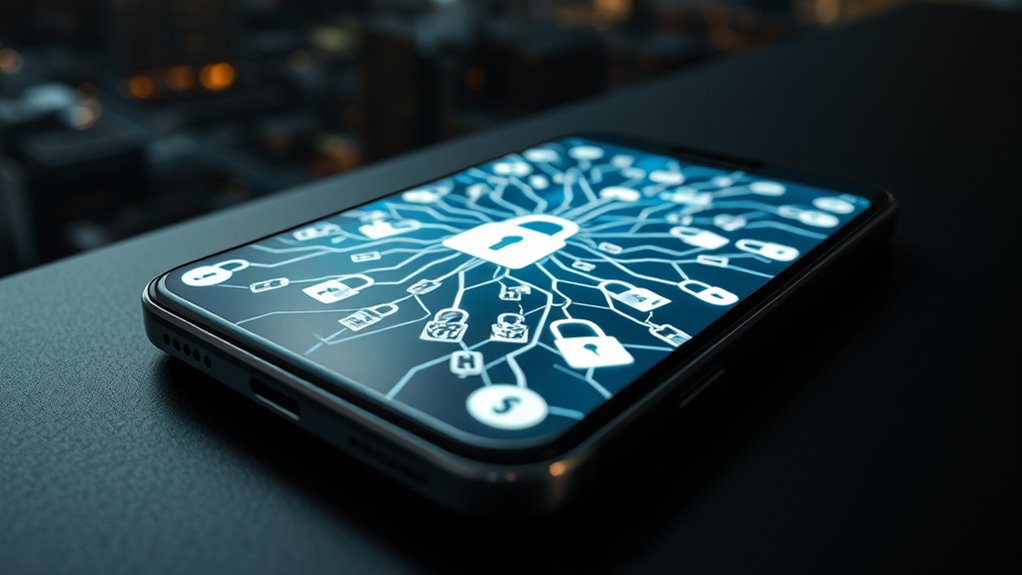
Have you ever wondered what aspects of your data security fall outside the scope of Ring’s end-to-end encryption? While it protects your footage during transmission and storage, some vulnerabilities remain. For example:
- Access controls: If your account isn’t properly secured, unauthorized users can access your footage despite encryption.
- User authentication: Weak passwords or compromised credentials can allow intruders into your account before encryption even comes into play.
- Device security: If your device is physically accessible or insecure, attackers could bypass encryption altogether.
- Network vulnerabilities: Public Wi-Fi or untrusted networks can expose your login details, making encryption ineffective without proper safeguards.
- The role of creative practice in developing robust security habits can also contribute to better overall protection.
Encryption doesn’t cover these weaknesses, so strengthening access controls and user authentication is essential.
Limitations in Device Security and Physical Access

Your device’s security can be vulnerable if it’s not properly protected, exposing your data to risks. Physical access to your hardware can bypass encryption measures entirely, making it a critical concern. Ultimately, end-device security limits mean that encryption alone can’t prevent all potential breaches. Regularly updating your device’s security protocols and being aware of security vulnerabilities can help mitigate some risks.
Device Vulnerabilities and Risks
Despite the strong security features of end-to-end encryption, devices themselves can still be vulnerable to attacks or physical breaches. Hardware vulnerabilities and firmware exploits pose significant risks, allowing attackers to bypass encryption altogether. Here are key concerns:
- Hardware vulnerabilities in chips or sensors can be exploited to access data directly.
- Firmware exploits may allow malicious code to persist even after software updates.
- Physical access can enable tampering or device replacement, undermining security.
- Insecure storage of encryption keys on devices increases the risk of extraction by attackers.
- The presence of low-level hardware flaws can compromise entire security architectures even when encryption protocols are robust.
Even with robust encryption, these device-level risks highlight the importance of securing hardware and firmware alongside software protections.
Physical Access Challenges
While end-to-end encryption protects data during transmission and storage, physical access to devices remains a significant vulnerability. If someone gains physical access, they can perform physical tampering, such as connecting hardware tools to bypass security measures or extract data directly from the device. Hardware vulnerabilities, like insecure chips or ports, can be exploited to access sensitive information without decrypting it. Physical tampering can also involve replacing components or installing malicious hardware to monitor or control the device’s functions. Ensuring proper device security, such as secure enclosures and tamper-evident features, becomes essential to prevent unauthorized physical access and protect your data from physical threats. Additionally, vetted hardware designs play a crucial role in minimizing hardware-related vulnerabilities.
End-Device Security Limits
Can encryption alone fully safeguard your devices? Not quite. Your device’s security depends heavily on its firmware and the robustness of network protocols. If someone gains physical access, they might bypass encryption through hardware manipulation or firmware exploits. Additionally, vulnerabilities in network protocols can expose data before encryption even begins. For example, outdated firmware can contain security flaws that are exploitable by attackers. Consider these limitations: 1. Physical access can lead to hardware tampering or data extraction. 2. Outdated device firmware may contain security flaws. 3. Weak or misconfigured network protocols can be exploited. 4. Attackers can use firmware or hardware vulnerabilities to bypass encryption. While end-to-end encryption protects your data in transit, it can’t prevent physical breaches or hardware-level attacks. Securing devices requires a layered approach beyond just encryption.
The Role of Cloud Storage and Data Backups

Have you ever wondered how cloud storage and data backups enhance your digital security? They act as essential layers of protection, guaranteeing your data remains safe even if your device is compromised. Cloud storage allows you to store files remotely, so even if your device is lost or hacked, your information stays protected and accessible from other devices. Data backups create copies of your important data, safeguarding against accidental deletion, hardware failure, or malware attacks. When stored properly, these backups can be encrypted and stored securely in the cloud, adding an extra layer of security. Additionally, implementing secure access controls ensures only authorized users can retrieve sensitive information, further strengthening your data protection measures. While end-to-end encryption protects data during transmission, cloud storage and backups ensure your data remains safe and recoverable, giving you peace of mind that your information is protected beyond the device level.
Potential Vulnerabilities and Security Gaps
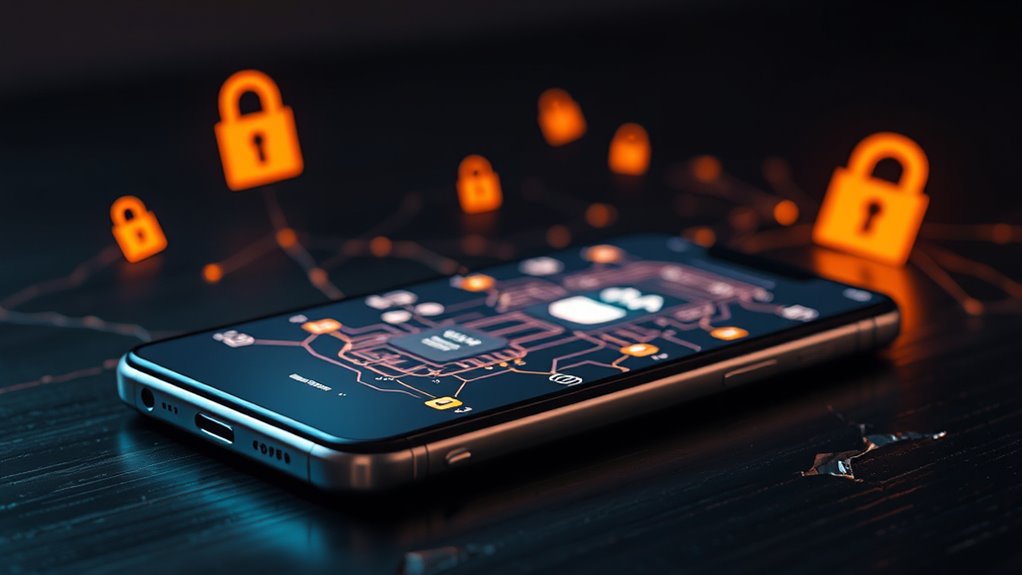
Despite the strengths of cloud storage and data backups, they’re not immune to vulnerabilities. Firmware flaws can be exploited to gain unauthorized access, bypassing encryption protections. Weak user authentication methods, like simple passwords or lack of multi-factor authentication, increase risk of breaches. Here are some key vulnerabilities:
- Firmware vulnerabilities that allow attackers to manipulate device behavior.
- Inadequate user authentication, enabling unauthorized device access.
- Exploits targeting software updates or patches.
- Insider threats due to insufficient access controls.
These gaps highlight the importance of regularly updating firmware, strengthening user authentication, and monitoring for suspicious activity to mitigate potential security breaches.
User Responsibilities for Maintaining Privacy
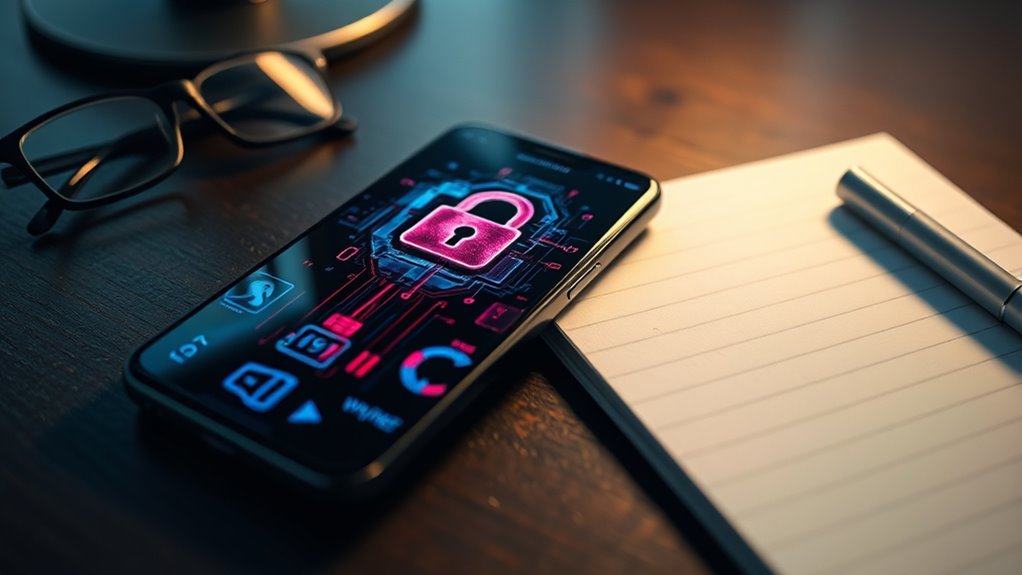
Maintaining your privacy while using end-to-end encryption requires active responsibility on your part. Your user responsibility includes choosing strong, unique passwords and enabling two-factor authentication to prevent unauthorized access. Be cautious when sharing sensitive information and verify the identities of contacts before engaging in private conversations. Regularly update your apps and devices to patch security vulnerabilities. Avoid clicking on suspicious links or downloading unknown files that could compromise your privacy. Additionally, review privacy settings regularly to ensure they align with your comfort level. Remember, while encryption protects your data during transmission, your privacy stewardship depends on your actions. Staying vigilant and proactive helps safeguard your communications and keeps your private information secure.
How Law Enforcement and Third Parties Interact With Encrypted Data
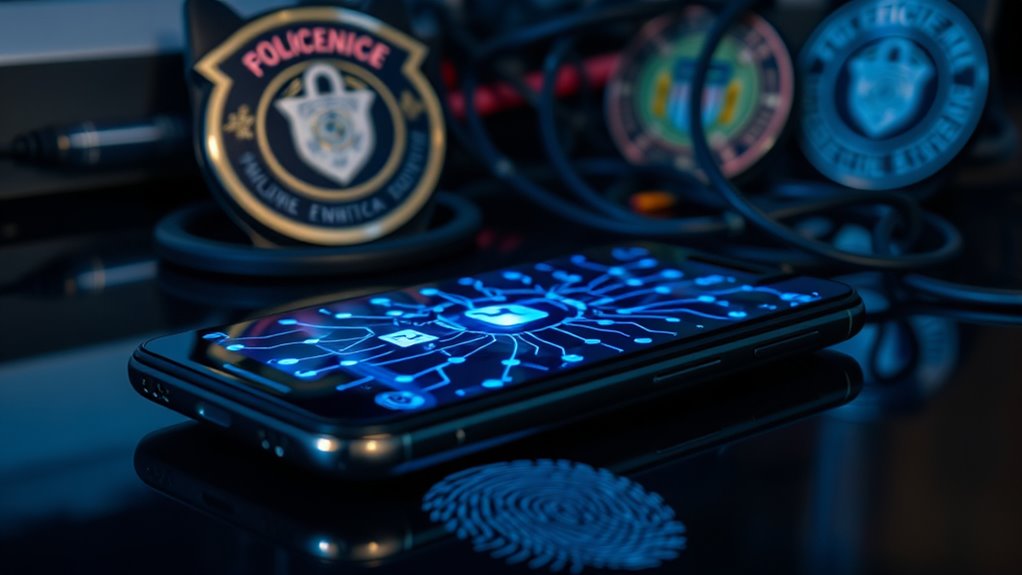
While your efforts to protect your privacy are essential, law enforcement and third parties have developed methods to access or analyze encrypted data. They often seek legal access through court orders or warrants to bypass encryption. Government surveillance programs can also monitor metadata or use hacking techniques to gather information. Here are four common methods they use:
Law enforcement and third parties can access encrypted data through legal orders, metadata analysis, exploits, or malware.
- Legal Orders: Court mandates compel service providers to share decrypted data or assist with access.
- Metadata Analysis: They analyze connection logs and activity patterns, even if content remains encrypted.
- Backdoors and Exploits: Authorities sometimes exploit vulnerabilities or request backdoors in encryption standards.
- Third-Party Interception: Using malware or spyware to intercept data before encryption or after decryption.
These approaches highlight the ongoing tension between privacy and government surveillance.
Best Practices to Enhance Overall Digital Privacy
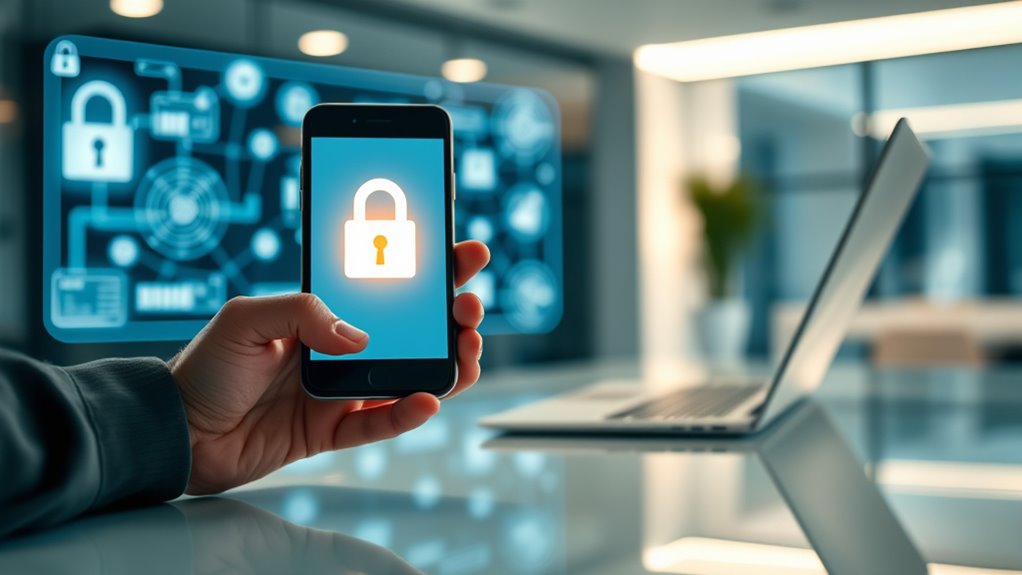
To effectively enhance your overall digital privacy, you should adopt a combination of proactive practices and strategic tools. Use strong encryption algorithms to safeguard your data and ensure your communications stay private. Implement robust user authentication methods, like two-factor authentication, to prevent unauthorized access. Regularly update software and security patches to close vulnerabilities. Be cautious with public Wi-Fi and avoid sharing sensitive information unless protected by a VPN. Consider using privacy-focused browsers and encrypted messaging apps. The table below illustrates key practices:
| Practice | Purpose | Example Tools |
|---|---|---|
| Use strong encryption algorithms | Protect data integrity | AES, ChaCha20 |
| Implement user authentication | Verify identities | 2FA, biometrics |
| Keep software updated | Fix security vulnerabilities | Auto-updates |
| Avoid unsecured networks | Prevent data interception | VPNs |
Frequently Asked Questions
Can Ring Encryption Be Bypassed by Hackers?
You wonder if hackers can bypass Ring encryption. While end-to-end encryption offers strong protection, hacking vulnerabilities still exist, especially if your device or network has security flaws. Skilled hackers might attempt encryption bypass methods, exploiting weak points in your setup. However, with proper updates and secure practices, you reduce the risk considerably. Remember, no system is completely invulnerable, so stay vigilant and keep your devices protected.
Does End-To-End Encryption Affect Emergency Response Times?
Imagine a crisis unfolding where every second counts. End-to-end encryption can cause response delays in emergency communication, as authorities might struggle to access essential footage quickly. While it protects your privacy, it could slow down critical response times, leaving you wondering if safety comes at a cost. Sometimes, encryption’s protective shield might inadvertently hinder emergency responders, making you question whether security measures are truly helping or unintentionally delaying help.
Are There Legal Restrictions on Ring’s Encryption in Certain Countries?
You might wonder if legal restrictions or encryption bans affect Ring’s end-to-end encryption. In some countries, authorities push for backdoors or restrict encryption, making it harder for companies to implement full protection. These legal restrictions can limit how Ring deploys encryption features or require compliance with local laws. As a result, your privacy could be compromised or your data accessible to authorities, depending on your country’s regulations.
How Often Does Ring Update Its Encryption Protocols?
Think of Ring’s encryption protocols as a fortress that needs regular reinforcement. Their encryption update frequency depends on security needs, but generally, they follow a protocol upgrade schedule that keeps pace with emerging threats. Ring updates its encryption protocols periodically, often in response to vulnerabilities or industry standards, ensuring your footage stays protected. Staying vigilant, they aim to stay one step ahead, like a watchful guardian guarding your privacy.
What Are the Privacy Implications of Ring’s Data Sharing Policies?
You should be aware of the privacy concerns linked to Ring’s data sharing policies. When you use Ring devices, your footage and data might be shared with third parties or law enforcement, raising privacy issues. This data sharing can expose your personal information and activity patterns. It is crucial to review Ring’s policies carefully to understand what data they collect, how it’s shared, and how you can control your privacy settings.
Conclusion
Think of Ring’s encryption like a vault with a sturdy lock—it’s great at protecting your valuables, but if someone gets a key or breaks in, your privacy is compromised. Just like locking your doors isn’t enough if a thief has a crowbar, relying solely on encryption isn’t enough if device security falters. Stay vigilant, update your software, and understand what’s protected—and what’s not—to truly keep your digital world safe.




